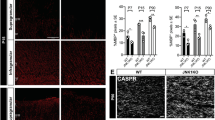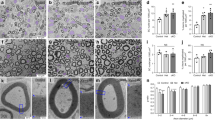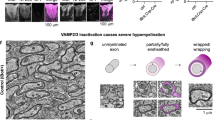Abstract
The control of myelination by oligodendrocytes in the CNS is poorly understood. Here we show that LINGO-1 is an important negative regulator of this critical process. LINGO-1 is expressed in oligodendrocytes. Attenuation of its function by dominant-negative LINGO-1, LINGO-1 RNA-mediated interference (RNAi) or soluble human LINGO-1 (LINGO-1-Fc) leads to differentiation and increased myelination competence. Attenuation of LINGO-1 results in downregulation of RhoA activity, which has been implicated in oligodendrocyte differentiation. Conversely, overexpression of LINGO-1 leads to activation of RhoA and inhibition of oligodendrocyte differentiation and myelination. Treatment of oligodendrocyte and neuron cocultures with LINGO-1-Fc resulted in highly developed myelinated axons that have internodes and well-defined nodes of Ranvier. The contribution of LINGO-1 to myelination was verified in vivo through the analysis of LINGO-1 knockout mice. The ability to recapitulate CNS myelination in vitro using LINGO-1 antagonists and the in vivo effects seen in the LINGO-1 knockout indicate that LINGO-1 signaling may be critical for CNS myelination.
This is a preview of subscription content, access via your institution
Access options
Subscribe to this journal
Receive 12 print issues and online access
$209.00 per year
only $17.42 per issue
Buy this article
- Purchase on Springer Link
- Instant access to full article PDF
Prices may be subject to local taxes which are calculated during checkout





Similar content being viewed by others
References
Edgar, J.M. & Garbern, J. The myelinated axon is dependent on the myelinating cell for support and maintenance: molecules involved. J. Neurosci. Res. 76, 593–598 (2004).
Garbay, B., Heape, A.M., Sargueil, F. & Cassagne, C. Myelin synthesis in the peripheral nervous system. Prog. Neurobiol. 61, 267–304 (2000).
Trapp, B.D., Ransohoff, R. & Rudick, R. Axonal pathology in multiple sclerosis: relationship to neurologic disability. Curr. Opin. Neurol. 12, 295–302 (1999).
Trapp, B.D., Bo, L., Mork, S. & Chang, A. Pathogenesis of tissue injury in MS lesions. J. Neuroimmunol. 98, 49–56 (1999).
Villagra, N.T. et al. PML bodies in reactive sensory ganglion neurons of the Guillain-Barre syndrome. Neurobiol. Dis. 16, 158–168 (2004).
Kiewe, P. et al. Progressive multifocal leukoencephalopathy with detection of JC virus in a patient with chronic lymphocytic leukemia parallel to onset of fludarabine therapy. Leuk. Lymphoma 44, 1815–1818 (2003).
Kolodny, E.H. Dysmyelinating and demyelinating conditions in infancy. Curr. Opin. Neurol. Neurosurg. 6, 379–386 (1993).
Salvati, S., Attorri, L., Avellino, C., Di Biase, A. & Sanchez, M. Diet, lipids and brain development. Dev. Neurosci. 22, 481–487 (2000).
Stoffel, W. & Bosio, A. Myelin glycolipids and their functions. Curr. Opin. Neurobiol. 7, 654–661 (1997).
Friede, R.L. Relation between myelin sheath thickness, internode geometry, and sheath resistance. Exp. Neurol. 92, 234–247 (1986).
Michailov, G.V. et al. Axonal neuregulin-1 regulates myelin sheath thickness. Science 304, 700–703 (2004).
Chan, J.R. et al. NGF controls axonal receptivity to myelination by Schwann cells or oligodendrocytes. Neuron 43, 183–191 (2004).
Wang, S. et al. Notch receptor activation inhibits oligodendrocyte differentiation. Neuron 21, 63–75 (1998).
Vartanian, T., Goodearl, A., Viehover, A. & Fischbach, G. Axonal neuregulin signals cells of the oligodendrocyte lineage through activation of HER4 and Schwann cells through HER2 and HER3. J. Cell Biol. 137, 211–220 (1997).
Givogri, M.I. et al. Central nervous system myelination in mice with deficient expression of Notch1 receptor. J. Neurosci. Res. 67, 309–320 (2002).
Garratt, A.N., Britsch, S. & Birchmeier, C. Neuregulin, a factor with many functions in the life of a Schwann cell. Bioessays 22, 987–996 (2000).
Liang, X., Draghi, N.A. & Resh, M.D. Signaling from integrins to Fyn to Rho family GTPases regulates morphologic differentiation of oligodendrocytes. J. Neurosci. 24, 7140–7149 (2004).
Mi, S. et al. LINGO-1 is a component of the Nogo-66 receptor/p75 signaling complex. Nat. Neurosci. 7, 221–228 (2004).
Shao, Z. et al. Taj/Troy, an orphan TNF receptor family member, interacts with the Nogo-66 receptor and regulates axonal regeneration. Neuron 45, 353–359 (2005).
Park, J. et al. A TNF receptor family member TROY is a co-receptor with Nogo receptor in mediating the inhibitory activity of myelin inhibitors. Neuron 45, 345–351 (2005).
Osterhout, D.J., Wolven, A., Wolf, R.M., Resh, M.D. & Chao, M.V. Morphological differentiation of oligodendrocytes requires activation of Fyn tyrosine kinase. J. Cell Biol. 145, 1209–1218 (1999).
Svenningsen, A.F., Shan, W.S., Colman, D.R. & Pedraza, L. Rapid method for culturing embryonic neuron-glial cell cocultures. J. Neurosci. Res. 72, 565–573 (2003).
Sperber, B.R. & McMorris, F.A. Fyn tyrosine kinase regulates oligodendroglial cell development but is not required for morphological differentiation of oligodendrocytes. J. Neurosci. Res. 63, 303–312 (2001).
Wolf, R.M., Wilkes, J.J., Chao, M.V. & Resh, M.D. Tyrosine phosphorylation of p190 RhoGAP by Fyn regulates oligodendrocyte differentiation. J. Neurobiol. 49, 62–78 (2001).
Sperber, B.R. et al. A unique role for Fyn in CNS myelination. J. Neurosci. 21, 2039–2047 (2001).
Kramer, E.M., Klein, C., Koch, T., Boytinck, M. & Trotter, J. Compartmentation of Fyn kinase with glycosylphosphatidylinositol-anchored molecules in oligodendrocytes facilitates kinase activation during myelination. J. Biol. Chem. 274, 29042–29049 (1999).
Melendez-Vasquez, C.V., Einheber, S. & Salzer, J.L. Rho kinase regulates schwann cell myelination and formation of associated axonal domains. J. Neurosci. 24, 3953–3963 (2004).
Kaplan, M.R. et al. Induction of sodium channel clustering by oligodendrocytes. Nature 386, 724–728 (1997).
Bhat, R.V. et al. Expression of the APC tumor suppressor protein in oligodendroglia. Glia 17, 169–174 (1996).
Rubinson, D.A. et al. A lentivirus-based system to functionally silence genes in primary mammalian cells, stem cells and transgenic mice by RNA interference. Nat. Genet. 33, 401–406 (2003).
Partadiredja, G., Miller, R. & Oorschot, D.E. The number, size, and type of axons in rat subcortical white matter on left and right sides: a stereological, ultrastructural study. J. Neurocytol. 32, 1165–1179 (2003).
Li, C., Trapp, B., Ludwin, S., Peterson, A. & Roder, J. Myelin associated glycoprotein modulates glia-axon contact in vivo. J. Neurosci. Res. 51, 210–217 (1998).
Zhang, Y., Muyrers, J.P., Testa, G. & Stewart, A.F. DNA cloning by homologous recombination in Escherichia coli. Nat. Biotechnol. 18, 1314–1317 (2000).
Acknowledgements
We thank J. Mason and other LINGO-1 team members and the research management team from Biogenidec for discussions.
Author information
Authors and Affiliations
Corresponding author
Ethics declarations
Competing interests
The authors declare no competing financial interests.
Rights and permissions
About this article
Cite this article
Mi, S., Miller, R., Lee, X. et al. LINGO-1 negatively regulates myelination by oligodendrocytes. Nat Neurosci 8, 745–751 (2005). https://doi.org/10.1038/nn1460
Received:
Accepted:
Published:
Issue Date:
DOI: https://doi.org/10.1038/nn1460
This article is cited by
-
In individuals with Williams syndrome, dysregulation of methylation in non-coding regions of neuronal and oligodendrocyte DNA is associated with pathology and cortical development
Molecular Psychiatry (2023)
-
Inflammation in multiple sclerosis: consequences for remyelination and disease progression
Nature Reviews Neurology (2023)
-
Neuroglial components of brain lesions may provide new therapeutic strategies for multiple sclerosis
Neurological Sciences (2023)
-
Inhibition of LINGO1 as a therapeutic target to promote axonal regeneration and repair for neurological disorders
3 Biotech (2023)
-
B cell-dependent EAE induces visual deficits in the mouse with similarities to human autoimmune demyelinating diseases
Journal of Neuroinflammation (2022)



